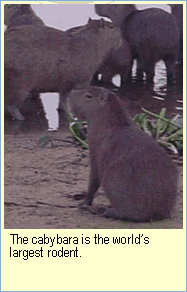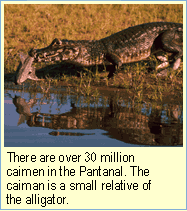| |
 Welcome to Brazil, the only country in South America to speak Portuguese and home to the famous Amazon River. In the southwest area of Brazil is the Pantanal area. The Pantanal is the world's largest freshwater wetlands. In fact, the word pantanal comes from the Portuguese word for "swamp" — pantano. Welcome to Brazil, the only country in South America to speak Portuguese and home to the famous Amazon River. In the southwest area of Brazil is the Pantanal area. The Pantanal is the world's largest freshwater wetlands. In fact, the word pantanal comes from the Portuguese word for "swamp" — pantano.
 a video of the Pantanal in January 2002 and see how many species of plants and animals you can spot. (Courtesy of Scott Darlington) a video of the Pantanal in January 2002 and see how many species of plants and animals you can spot. (Courtesy of Scott Darlington)
Earthwatch has a home base in the southern part of the Pantanal called the Fazenda Rio Negro. "Fazenda" means "farm" in Portuguese, and this farm sits right on the Rio Negro, giving the name to our home base.
The Pantanal is home to one of the greatest concentrations of wildlife in South America. There are over 3,500 species of plants, over 600 species of birds, 102 species of mammals, 177 species of reptiles, and 264 species of fish. Every day of being in the Pantanal, you will see caiman, capybaras, anteaters, tapirs, jabiru storks, hyacinth macaws, rheas, and even the endangered giant river otter. You may even hear a jaguar growl and you will certainly find jaguar tracks.
 The landscape of the Pantanal includes a variety of habitats ranging from grasslands and forests to lakes and rivers. The variety of habitats has a lot to do with wet and dry seasons. During the wet season from November to March, heavy rains flood the river channels and wetland basins, creating a network of interconnected waterways. During the dry seasons, the wetlands shrink, increasing the area of grasslands. This seasonal flooding contributes to habitats rich in productivity and food resources, which in turn support a diversity of plants and animals.
The landscape of the Pantanal includes a variety of habitats ranging from grasslands and forests to lakes and rivers. The variety of habitats has a lot to do with wet and dry seasons. During the wet season from November to March, heavy rains flood the river channels and wetland basins, creating a network of interconnected waterways. During the dry seasons, the wetlands shrink, increasing the area of grasslands. This seasonal flooding contributes to habitats rich in productivity and food resources, which in turn support a diversity of plants and animals.
The Pantanal is a unique ecosystem, and scientists do not know the extent to which human activities may be threatening this special environment. Some of the threats include:
- cattle ranching;
- destruction of habitat;
- pollution of the rivers from agriculture and mining;
- industrial development in the highlands.
In 2000, Earthwatch Institute formed a research partnership with Conservation International to collect baseline information and monitor all aspects of the Pantanal ecosystem on a long-term basis. Today there are eight research projects, including studies of fish, aquatic invertebrates, birds, and fruit species. There are also research projects on predators on the top of the food web like the jaguar and the endangered river otter.
All of the projects share a common goal: to conserve the Pantanal.
Top photo courtesy
of Amy Biasucci. Bottom photo courtesy of Mark Chandler/Earthwatch Institute.
|
 |

